Girona hotel Palau Fugit marries rich cultural heritage with modern craft
Palau Fugit is a seductive Girona hotel – an abandoned 18th-century palace with an interior transformation by El Equipo Creativo
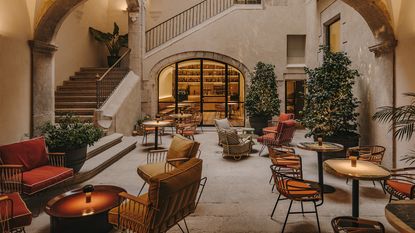
Girona offers far more than meets the eye. Beyond its enticing blend of gastronomy, culture, and natural beauty, the capital of Catalonia's Empordà region also harbours the remnants of Spain's most important Jewish community, featuring historic sites like El Call (the Jewish Quarter). This rich cultural tapestry served as the muse for El Equipo Creativo, an interior architecture studio, as it undertook the transformation of an abandoned 18th-century palace into a seductive boutique Girona hotel, Palau Fugit.
Palau Fugit, a tranquil escape in Girona
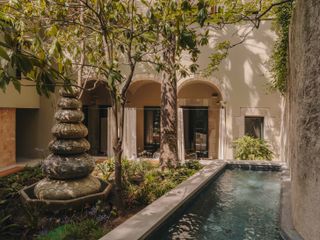
Palau Fugit's patio area
The location is nestled deep within Girona's atmospheric Barri Vell (Old Quarter). 'We aimed to create a sense of high luxury minus the pretensions. To respect the original architecture, of course, but be fresh, elegant, surprising and a little disruptive at times,' shares the team.
The hotel’s weathered stone façades, hidden cul-de-sacs, porticoes, and stone ramparts combine with a palette of vibrant colours, inspired by the local townhouses that flank the River Onyar and Girona’s annual 'El Temps de Flors' flower festival, forming a backdrop for contemporary art and craft. Palau Fugit beckons exploration and enjoyment, and comprises two main structures: the historic 'El Palauet' and a modern extension known as 'El Pavelló'.
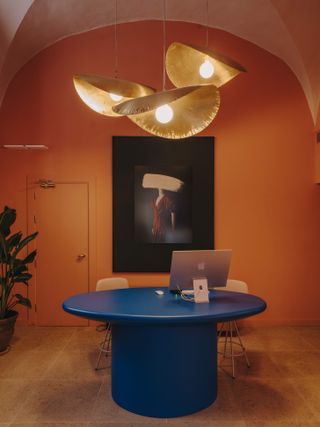
The hotel's reception, featuring a custom Yves Klein blue table and a golden chandelier
Isern Associats, a Barcelona-based architectural firm, renovated the historic structure and designed the new addition, connecting the two with a terrace adorned with a small swimming pool, lush ferns and a central sculpture, Font de Gararotes, by the local artist Frederic Amat.
The heart of the experience lies in 'La Placeta', a charming courtyard accessed through an arched entrance via El Palauet. In this historic part of the hotel, you'll find the reception area, restaurant, cocktail bar, and a discreet spa for one.
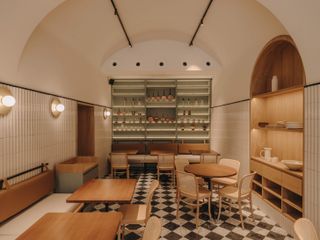
Casa Heras, the hotel's restaurant, blends historical elegance with modern comfort
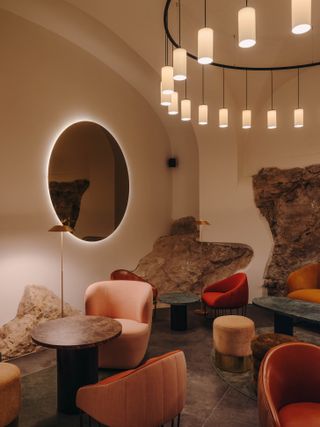
The Gipsy bar offers an intimate space for cocktails and conversations
Inside El Palauet, the decor is a contemporary twist on the opulence of the late 19th century. A feminine touch weaves throughout, recreating the ambiance of a noble family's residence. The reception area, featuring a custom Yves Klein blue table and a golden chandelier, leads guests to rooms via the original staircase of La Placeta.
The first set of rooms is adorned with original works by local artists, offering a palette of stone shades, soft blues, greys, and blush tones that revive original features such as ceiling roses and carved balcony shutters. In contrast, El Pavelló's rooms embrace a Mediterranean-inspired dolce vita theme, with terracotta hues, locally crafted ceramics, and wooden accents, all bathed in ample natural light.
Wallpaper* Newsletter
Receive our daily digest of inspiration, escapism and design stories from around the world direct to your inbox.
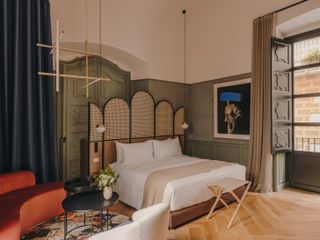
A guest room inside El Palauet
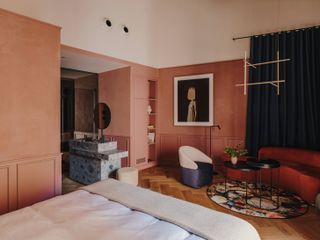
A guest room inside El Palauet
The tranquillity of Palau Fugit continues at Casa Heras, the hotel's restaurant, which blends historical elegance with modern comfort. Modern art and objects continue to enhance the space, including imaginative murals by Joana Santamans and sparkling copper fixtures. Within, a setting for private banquets and meetings, known as 'La Biblioteca', emerges, with an oval marble table at its heart. Meanwhile, the Gipsy bar offers an intimate space for cocktails and conversations, surrounded by the ancient palace's walls.

A discreet spa for one is available to book within the facilities
Sofia de la Cruz is the Travel Editor at Wallpaper*. She was born in Madrid, Spain but moved to London when she was 14 years old. Being exposed to the city’s creative pulse at such a young age shaped her into the inquisitive professional she is today. Before joining the Wallpaper* team in 2023, she worked for Hypebae and Hypebeast UK, where she focused on the intersection of art, fashion, and culture. Additionally, she contributed to Futurevvorld by covering a variety of sustainability topics.
-
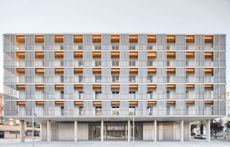 RIBA International Prize 2024 goes to 'radical housing' in Barcelona
RIBA International Prize 2024 goes to 'radical housing' in BarcelonaRIBA International Prize 2024 has been announced, and the winner is Modulus Matrix: 85 Social Housing in Cornellà, designed by Peris + Toral Arquitectes in Barcelona
By Ellie Stathaki Published
-
 Discover psychedelic landscapes and mind-bending art at London’s Tate Modern
Discover psychedelic landscapes and mind-bending art at London’s Tate Modern'Electric Dreams' at the Tate encompasses the period from the 1950s to the beginning of the internet era
By Hannah Silver Published
-
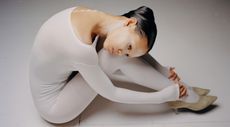 ‘If someone says no, you’re talking to the wrong person’: how make-up artist Marcelo Gutierrez created his own universe in New York
‘If someone says no, you’re talking to the wrong person’: how make-up artist Marcelo Gutierrez created his own universe in New YorkFresh from publishing his first book ‘Nothing Precious’, Marcelo Gutierrez speaks with Mary Cleary about his friends, collaborators and making it as a young creative in New York City
By Mary Cleary Published